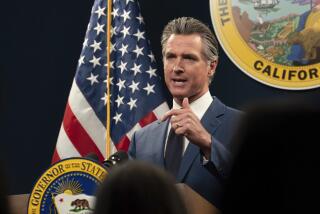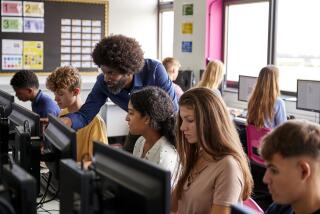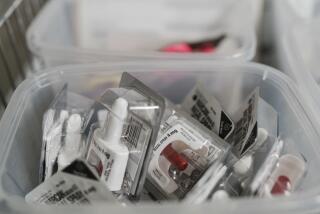Newsom promises $2 billion in hopes of reopening elementary schools beginning in February

California students in kindergarten through second grade would be allowed back on campus when pandemic conditions improved under a proposal announced.
- Share via
SACRAMENTO — Gov. Gavin Newsom on Wednesday announced a $2-billion package of incentives to encourage a return to in-person classes for California elementary school students as early as mid-February, an effort that could require frequent coronavirus testing for students, teachers and staff.
But given the bleak public health conditions across most of the state as coronavirus cases surge at alarming rates, it is unclear how quickly districts in hard-hit counties will qualify to reopen, especially those in large urban areas in Southern California and the San Francisco Bay Area.
Newsom’s decision, in essence, eases the strict criteria for county health conditions under which schools can be eligible to reopen. His plan comes amid California’s most deadly spell in the pandemic and increases pressure on local school officials to reinstate in-classroom learning.
In his announcement, Newsom cited growing evidence that young students faced “decreased risks” associated with the coronavirus and benefited more from in-person instruction compared to at-home learning. In-classroom learning provides a better opportunity to identify children suffering from depression, anxiety or abuse at home, he said.
“In-person instruction — there’s just no substitute for it. It’s so much more difficult for a 4-year-old to focus on a device than a 14-year-old,” said Newsom, the father of four young children. “That’s why this is so important that we move forward in a phased way, prove that we can do this right and effectively and safely, with an eye on everybody’s health and safety first and foremost.”
Dr. Anthony Fauci, director of the National Institute of Allergy and Infectious Disease, on Wednesday emphasized the importance reopening campuses.
“If we really want to get society back to some form of normality one of the first things you have to do is get children back in school,” Fauci said during a virtual event with Newsom on Wednesday.
Parents will still have the option to keep their children learning from home, even if their local schools reopen.
Newsom’s plan, expected to be submitted to the Legislature as an adjustment of the state budget for the current fiscal year, prioritizes returning students in kindergarten through the second grade as well as those with special instructional needs. The remainder of elementary school students could return as early as sometime in March. It remained unclear when older students would return to campuses.
Students who return to school would be required to wear face coverings. School employees would have to wear surgical masks.
Before a school can return to in-person classes, school districts must submit their safety reopening plans to both state and local health officials. Local health departments would have the authority to reject that plan but, once schools open, those agencies would have an obligation to provide them coronavirus monitoring, technical assistance and other support, Newsom said.
Newsom said schools in counties with a seven-day average of fewer than 28 cases per 100,000 residents would be eligible to open — a threshold that allows some campuses in purple tier regions, the most restrictive, to reopen. Los Angeles County and many other urban areas are experiencing far higher rates of transmission and would not be expected to reopen for some time.
The adjusted case rate in L.A. County, for example, is 66 per 100,000 residents; Orange County, 54; San Diego County, 38; Ventura County, 40 and San Bernardino County, 83.
Campuses that had already opened in these counties can remain open, regardless of the infection rate. And campuses can continue to open under waivers for elementary schools and to serve students with special needs, such as students with disabilities and students learning English.
The amount of coronavirus testing required will depend on the severity of the the virus’ spread in each county. Those minimally affected counties will only be required to test students, teachers and staff who are symptomatic or have been in contact with someone with COVID-19. In counties where virus transmission is widespread, weekly testing will be mandatory for everyone.
The state’s largest teachers union, California Teachers Assn., offered measured praise for Newsom, while also flagging concerns.
The new framework is fully in line with the union’s repeated calls “for tougher safety standards, rigorous and consistent testing, data collection and transparency,” said union President E. Toby Boyd. All the same, “there are many unanswered questions and the devil is always in the details, particularly as it relates to implementation and execution.”
Boyd said he hopes the details will reveal “a coherent statewide plan rather than creating more confusion for parents and school districts.”
Noting the state’s ongoing health crisis, Boyd said his union “continues to support distance learning” for schools in counties that remain in the purple tier.
“This must be a joint effort to ensure a safe return to our classrooms where we know our students learn best and thrive,” Boyd said.
Local teachers unions will have an influential say on school reopening plans, which will require bargaining between the labor organizations and the district administration. Newsom defended that requirement, adding that he expects that teachers will be eager to return to the classroom because of their “deep desire for service.”
“It’s a foundational principle that workers should have a voice, that management should have a responsibility as well as an opportunity to learn and listen to that voice and have the collective wisdom and engage in a dialectic, and an important conversation,” Newsom said.
L.A. school board member Nick Melvoin said that while he supports the governor’s efforts, he worries that local politics or union bargaining positions could have more to do with campus reopenings than safety or science.
He would like to see the governor’s plan stipulate that “once you meet these public health conditions, you must provide an in-person option, at least for high-need students... What that option looks like would be bargained with unions,” he added, but it would have to be provided.
L.A. County Office of Education Supt. Debra Duardo praised the governor for bringing to bear more resources and consistency to the task of reopening schools. But she also emphasized the importance of vaccinations.
“I continue to urge the state to prioritize the vaccination of K-12 and early education teachers, administrators and staff as an essential step in getting our public schools and early learning and care centers fully reopened,” Duardo said in a statement.
Some education advocates may be particularly worried about the details of how the plan is funded. The proposal includes the $2 billion as part of the funding guaranteed to schools under the California Constitution — which means the money needed for coronavirus testing and new school safety measures would have otherwise been spent on a variety of existing school programs.
Under Newsom’s plan, districts that offer in-person instruction would receive about $450 per student, a figure that could increase to $750 per student to account for those from low-income families, English learners, foster youth and others with special education needs.
In November, superintendents from some of California’s largest school districts — including the Los Angeles Unified School District and Long Beach Unified School District — sent a letter to Newsom urging him to establish common statewide standards for school reopenings, including testing requirements. social distancing criteria and employee protections.
The governor’s announcement comes after months of demands for Newsom to lay out a more far-reaching, statewide set of guidelines for when K-12 campuses would reopen. The governor’s most notable decision on when to resume in-person learning, unveiled in July, still left the final decision in the hands of individual school districts as virus transmissions decreased in a number of California communities in early fall.
Critics said the result was an ever-widening gap between schools with resources, largely in affluent communities, and those serving lower-income families and left to full-time remote learning. Those criticisms also noted that a number of private schools were the ones to open first, and have been allowed to remain open even as local public health conditions have worsened.
Earlier this month, a group of prominent Democrats in the Legislature demanded a plan that would tightly link the return of in-person learning with reduced local virus transmissions. Legislation introduced earlier this month would require school districts to open campuses in California counties that had been removed from the most restrictive purple tier of COVID-19 protections. Current policy makes it optional for schools to reopen in the less restrictive tiers.
The funds for the new effort will be included in Newsom’s budget proposal for the coming year, to be unveiled next week. Legislative analysts and the governor have estimated a large windfall of tax revenue — of $15.5 billion or more — resulting from a smaller than expected drop in personal income taxes paid by Californians. Some of the surprise revenue will, under longstanding rules, automatically be spent on public schools, but lawmakers could add more cash to that total in support of the governor’s proposal and other efforts.
The governor’s new proposal comes on top of about $6.5 billion that will be available to K-12 public schools from a new coronavirus relief package signed into law this week by President Trump.














